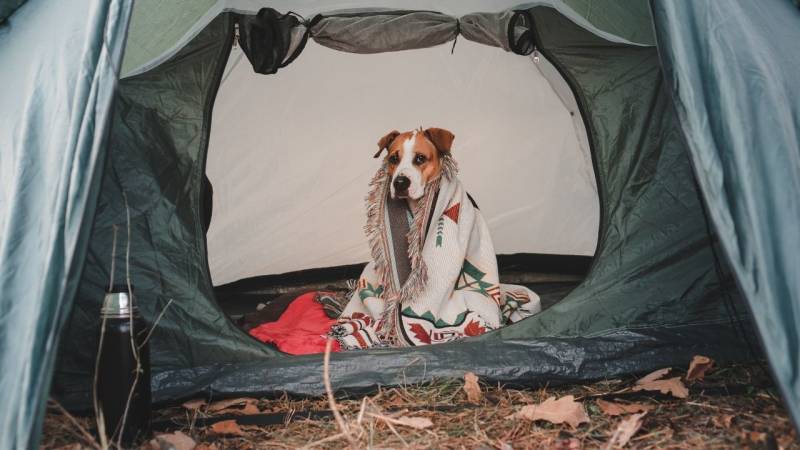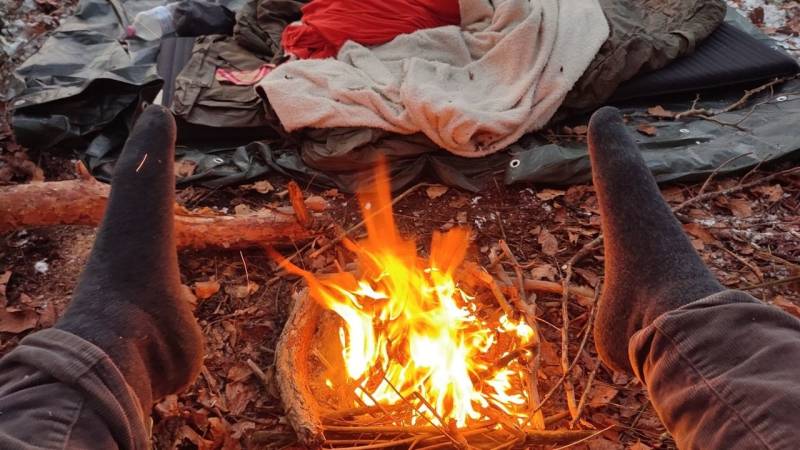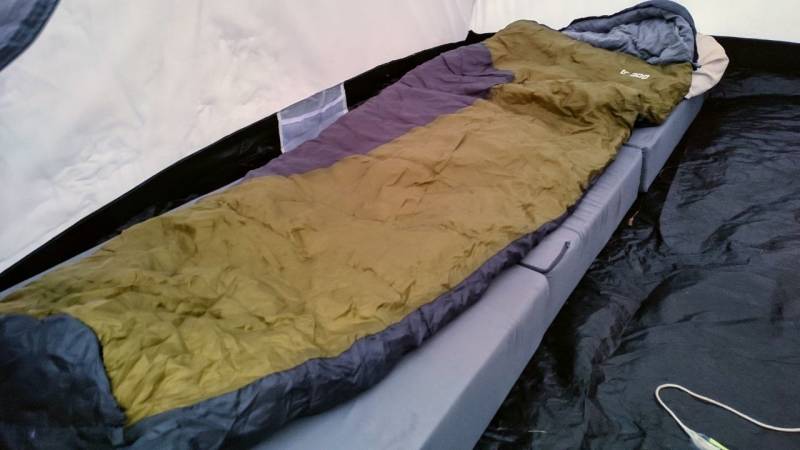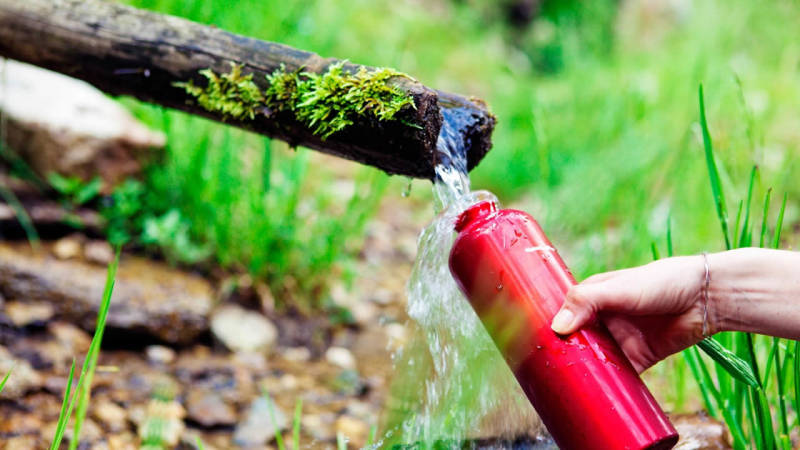
18 tips to stay warm while camping in a tent and sleeping bag and not freeze
👉 The key facts from this guide
- Use a safe tent heater to keep the tent warm.
- Bring extra blankets and emergency thermal blankets.
- Choose a sheltered campsite to block out the cold and wind.
- Use a temperature-resistant sleeping bag and keep your feet dry and warm.
- Ensure good ventilation of your tent to reduce moisture and condensation.
- Wear a hat in bed and use clean, dry sleepwear.
Camping is not only possible in summer.
The autumn, the winter, and the spring offer equally great stays in nature.
Now you're probably wondering what you can do to combat the cold in your tent and sleeping bag.
Because the cold may have kept you from going out until now.
I want to change that, and you will notice that you don't have to freeze while camping in winter.
This article now gives you tips on how to keep warm in the tent - and guarantees that you won't freeze.
Happy camping starts with staying warm - camping like a cold weather pro
I have often camped in Germany in autumn and winter - and it was icy.
Once, I realized after 10 minutes that I was still waiting for my tea to boil.

I stuck my head out of the awning and asked my partner if he had any idea why my water wouldn't boil.
He kindly pointed out to me that the gas cartridge I was using would be too cold at temperatures in the single digits.
So I had to warm up my gas cartridge first.
That was a beginner's mistake that I haven't made since then.
So I stuck the gas cartridge under my armpit (the only part of me that wasn't freezing at that time). That wasn't exactly a pleasure, so I learned the hard way.
After many years of trying out, I have now found many solutions that no longer make me tremble all night.
One of the most important lessons I have learned is that you don't have to pack ridiculous amounts to stay warm.
It's really worth investing in a few well-selected articles that have been specifically designed for comfortable camping.
I would like to give you the following tips. Try them out yourself, and you will see that you don't have to freeze while camping in winter.
1. The Obvious: Using a Safe Heater in the Tent
A tent heater is an obvious way to keep your tent warm. You use these heating devices directly in the tent.
However, I recommend not leaving the heater running all night.
Instead, I recommend running the heater for a while before going to bed and then turning it off before you go to sleep for the night.
Just like with portable gas heaters, you also need to be particularly careful here and follow the safety instructions. No heating device should be left on during sleep or for extended periods of time.
There are portable gas heaters (like those from Fritzmann, even with an oxygen depletion sensor) that may be tempting for campers, but they should only be used with great caution.
Gas heaters should NOT be used in a closed space such as the sleeping area of a tent and proper ventilation must be ensured.

If you're not a fan of gas heating and prefer traditional methods, perhaps because you're a Bushcrafter, then you can opt for a tent stove.
However, with the tent stove you will need a tent - preferably a tipi - that has an outlet for a chimney.
If you own such a tipi and a tent stove, you can be sure that you won't freeze in the tent anymore. On the contrary, you will be tearing off the thick sweaters due to the heat.

Pay attention to the following safety instructions:
Please consider using your common sense and follow the manufacturer's safety instructions. Never leave a gas heater/camping stove unattended, do not use it in any ventilated area inside your tent, and make sure to use a carbon monoxide alarm.
Recommended reading: Looking to buy a tent? Then read this ultimate guide to tents first
2. Cozy and warm: Bring extra blankets
At night, it can still be cold in Germany even in summer - don't assume that you only require a sleeping bag just because it's July.
Therefore, always bring some extra blankets with you - especially if you have children with you.
Thick, fluffy thermal blankets can make a big difference on cold nights.

Not having a blanket with you is a classic mistake made by beginners when camping. Therefore, read my guide: "The 25 biggest camping mistakes you should avoid as a beginner".
3. Thin and Lightweight: Emergency Thermal Blanket
Emergency thermal blankets (like these here), sometimes also known as rescue blankets and Mylar blankets, are a great way to keep the tent warm.
They are not suitable for emergencies and are usually inexpensive and available in most sports and camping stores.
You can use the emergency thermal blanket to keep yourself warm.

But also place it on your sleeping pad or air mattress, or even use it to reflect heat back onto you.
To reflect the heat with the emergency thermal blanket, attach it to the ceiling of your tent using adhesive tape. It reflects a large portion of the heat inside the tent, whether it's from your own body heat or from a recently used tent heater.
4. Smart Locations: Choose a Protected Campsite
The choice of the perfect campsite is crucial. If low temperatures are forecasted in the evening, you will be glad that you have chosen a sheltered camping spot.
Avoid low-lying areas where cold air accumulates. A location that is 15 meters above the valley floor should be sufficient to keep you warmer.
Find a campsite that is also protected from too much wind. A cold wind on a cold night can chill you to the bone.
Reading tip: How to find the ideal location for your bushcraft camp
5. Essential: Use a temperature-resistant sleeping bag
Make sure you have a high-quality, temperature-resistant sleeping bag.
I have written in my buying guide about the best sleeping bags and there are also models listed there that are perfect for temperatures below 0 degrees.

For maximum warmth, your sleeping bag should be rated for zero degrees. You may also want to invest in a fleece-lined inner sleeping bag.
With a liner, you can increase the temperature rating of your current or new sleeping bag by about 10 degrees.
Reading tip: How to wash your sleeping bag like a pro
6. Essential: Keep your feet dry and warm
Make sure your socks are completely dry before you get into your sleeping bag for the night.
Even slightly damp socks can cause you to lose a lot of heat through your feet (remember: moisture means cold!).
I recommend bringing a pair of extra socks just for sleeping and putting them on only when you go to bed.

It is important not to dress too warmly so that you don't start sweating. If you get too warm at night and start sweating, you will definitely wake up damp and cold.
Therefore, dress in layers that you can easily remove with your sleeping bag.
7. Pro Tip: Ensure good ventilation of your tent
Most people don't know that they need to ventilate their tent at night. That may sound a bit strange, but there is a good reason for it.
Your body heat and breath inside the tent can cause condensation to form, making everything inside the tent slightly damp.
By ventilating your tent, you can reduce moisture and condensation, ensuring that you and the interior of your tent stay dry - keeping you warmer throughout the night.
Equally important is that you try to protect yourself from sweating. If you wake up and notice that you are sweating, take off a few layers to keep yourself dry.
You don't want it to get too hot inside your tent.
To quote the immortal words of survival expert Les Stroud:
Who sweats, dies!
Ok, you probably won't die on your weekend trip, but you will definitely freeze if you sweat on a cold night.
P. S. If you have never slept outside in winter, be sure to read this experience report with valuable tips.
8. Drying: Air out your sleeping bag
After sleeping comfortably in your temperature-resistant sleeping bag all night, it's a promising idea to get rid of the moisture from the night.
Remember that moisture is synonymous with cold.
And the last thing you want to do after your first warm night is crawl into a cold, damp sleeping bag.
Spread out your sleeping bag completely and open it. Bonus points if you hang your sleeping bag outdoors.

9. Utilizing Science: Isolate the Base
An insulating mat is great, but sometimes it needs a little help. A cold floor can suck the warmth out of your body.
So, put an additional foam mat under your sleeping pad to increase the insulation in your tent (e.g., this one).
Alternatively, you can also place a layer of leaves and pine branches under your sleeping mat instead of bringing an additional groundsheet. It shouldn't be too difficult to find leaves and needles in the forests. If you're having trouble, you're probably camping in the wrong spot.
But be careful not to puncture your sleeping mat with needles or sharp branches.
Reading tip: Find the best sleeping pads - as well for winter camping
10. Get the blood flowing: Go to bed warm
To ignite the campfire within you, you should engage in physical activity before going into your tent.
Try doing jumping jacks, squats, or burpees before getting into your sleeping bag to get your blood flowing.
If you get cold in your sleeping bag, do a few crunches to warm yourself up. This way, you don't even have to leave your sleeping bag or tent.
Move just enough to warm up, but not so much that you start sweating.
11. Headgear: Wear a cap in bed
It may sound obvious, but wear a hat in bed. I have become so accustomed to it that I can't sleep in the cold without a hat anymore.
My hat (like this one) even has ear flaps to keep my ears warm.
All of our ancestors did this, so they wouldn't get cold at night.
You can lose a lot of body heat through your head if the rest of your body is covered.

Wearing a hat is also much better than simply sticking your head in the sleeping bag. Breathing inside the sleeping bag creates condensation, which leads to moisture.
And I know that by now you know what moisture means! (Hint: It's cold)
12. The Right Pajamas: Clean, Dry Sleepwear
The right clothing for sleeping is crucial to staying warm in your tent.
It is advisable that you always wear clothing that is explicitly intended for sleeping.
Loose cotton thermal clothing is an excellent choice for tent camping sleepwear.
It does not restrict blood circulation and keeps your blood flowing. Good blood circulation in the body helps you stay warm.
13. Water On: Drink plenty during the day
Make sure to consume enough fluids during the day and avoid drinking too much right before bedtime.
As a result, it is unlikely that you will have to get up and go pee at night.

If you absolutely have to pee at night, try using a pee bottle. Yes, I know it's easier for men.
But it works in two ways: you don't have to get out of bed, and you can use the now lukewarm bottle to warm up.
Hey, we do what we have to do in the forest! Besides, "holding on" to urine consumes valuable energy that you need to stay warm.
14. Simple Heating: Take a bottle with hot water to bed
Urine is not the only hot liquid you can bring to bed. There is also a lesser-known liquid called water, which is equally useful.
But joking aside because water is wonderful, precious, and extremely versatile.
For the cold nights, you should boil some water and fill it into a leak-proof, resealable bottle.
I recommend the Nomader Foldable Water Bottle or the Hydro Flask to keep water warm for hours, but any resealable bottle (including the Nalgene Water Bottles) will suffice.
Just be careful when using a bottle (glass, plastic, or metal) that is not suitable for hot liquids.
The hot water bottle is another option for all you campers out there. Like the bottles from Nomader and Hydro Flask, they are specifically designed for hot liquids and insulate them to keep them hot.
15. Delicious: Have a high-calorie dinner
Calories are a unit of heat. More calories mean more heat.
So don't feel guilty if you eat the second or third cereal bar on a cold night.
If you eat a small meal before going to bed, your stomach has something to do during the night. The act of digestion alone helps to warm up the body.

I highly recommend checking out my outdoor recipes. There, I show you how to cook a hearty bean pan or steak with mushrooms.
Furthermore, camp meals are entirely different in cold weather
I love bacon and eggs as a camping breakfast in summer and autumn, but eggs freeze in winter and cooking outdoors is difficult.
Simplify your meal plan with an easy-to-use gas stove and quick and easy meals, such as:
- Soups
- Grilled sandwiches
- Instant noodles
- Oatmeal
- Freeze-dried meals
Add peanut butter and jelly sandwiches, bagels, trail mix, and your favorite snacks.
And please keep in mind the thermos flask - it's a game changer.
Sometimes two of them make sense, especially on days when you are exposed to the cold for a long time. One contains my tea and the other has soup for lunch.
16. Protect your face: Use a scarf or balaclava
For those who don't know: A balaclava is a type of fabric headgear that covers the head and neck and leaves the face (usually only the eyes) exposed.

You can use a balaclava or a simple scarf that you wrap around your head and neck before going to bed.
In this way, your mouth and nose are kept out of the sleeping bag, but can still be covered if necessary.
In addition, a balaclava is ideal when it is very cold, or you are stuck in a snowstorm with your tent.
Read also
Camping in a Winter Storm: these 11 tips will help you stay safe - A winter storm can be a dangerous thing when camping. Take the necessary steps to stay as safe and comfortable as possible.
17. Geology: Hot Rocks
Put a few hand-sized stones in your campfire.
Heat them for about an hour and then let them cool down a bit. Once they are manageable but still warm, wrap the stones in a towel and place them in the foot area of your sleeping bag.
You can also place them in the middle of your tent and use them together with the emergency thermal blankets on the tent ceiling. That should keep your tent warm for hours.

An alternative method is digging a trench filled with hot stones.
While the stones are being heated in the fire, you dig a trench under the spot where your tent/sleeping area will be.
Make sure it extends the entire length of your body and is deep enough to cover all the stones with a few centimeters of soil.
Place the heated stones carefully in the pit and cover them with a few centimeters of soil. Set up your sleeping area on top of the buried stones and sleep comfortably.
But be careful: The use of hot stones is not recommended for unsupervised children or inexperienced campers. Never heat wet stones as they can expand and burst in the heat of the fire. This can cause hot embers and stone splinters to shoot out, which can cause serious injury.
18. Fun for Kids: Using Hand and Foot Warmers
On particularly cold nights, you should bring two disposable hand warmers - just for emergencies.
Place one of them near the foot end of your sleeping bag to keep your feet warm. Keep the other one close to your chest while you sleep.
Even if you drop it at night, it should stay in the sleeping bag and keep you warm.
Questions and Answers about Staying Warm in a Tent
How to stay warm in a tent?
Use sleeping mats, emergency blankets, tarps, a foam yoga mat, or even a bed of pine needles under your tent where the mattress will be placed. Investing in a high-quality sleeping mat can save space and help you stay warmer in your tent.
How cold is too cold for tent camping?
The quick answer is: Night temperatures below 4 degrees Celsius are too cold for inexperienced campers with cheap equipment to go camping. Night temperatures of about 10 to 18 degrees Celsius are the most comfortable for camping.
Is sleeping in a car warmer than in a tent?
Tents have a smaller volume, which means they heat up faster and they have double insulation. They are also made of special fabrics that prevent it from getting as cold as the aluminum that your car is made of. In short, it is warmer to sleep in a tent than sleeping in a car.
Can I sleep in the hammock during winter?
You can sleep in a hammock during winter, but you should take some precautions. First, make sure you have a good insulation layer underneath. Secondly, you should use a tarp to avoid getting wet in case of rain or snow.
Read more here: How to sleep safely and warmly in a hammock in winter
Is it warmer to sleep with clothes on?
Generally, wearing long underwear and clothing keeps you warmer. Your clothing acts as an additional insulation layer that keeps your natural body heat close and prevents it from escaping.
And, how do you like the tips for staying warm in the cold season?
Are there any other suggestions? Then write them to me and use the comment function for that.


Author of the guide
Martin Gebhardt
Hey, I'm Martin. On my blog, you will learn the basics and numerous details about living in the wild. I think survival, bushcraft and the good life in nature are the keys to happiness. Find me here on Instagram or on YouTube. You can find more about my mission on the About Me page.
Was this guide helpful?
43 people found this guide helpful.
5.00 out of 5 points (43 Ratings)
Comments (0)
This post may contain affiliate links. So if you click on the links and make a purchase, I will receive a small commission at no additional cost to you. Click here, to learn more about it.


